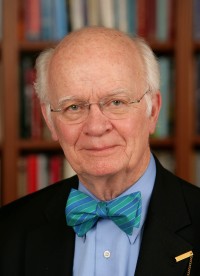Lighten up: Ecumenical lights
Observers of the Christian calendar celebrate Christmas for 12 days after December 25. Secularists and pagans who do not follow the church year hang their lights in the penitential season of Advent. Evidently some Christians have joined the secularists and pagans.
This we deduced last month from a story in USA Today (December 8), “Bright lights illuminate many ways,” in which reporter Cathy Lynn Grossman threw light on the subject, making reference to illumination in Islam, Buddhism and Hinduism and among Quakers and atheists.
The story interested us most when it dealt with the meaning of the color of lights. Grossman quoted Pam Danziger of Unity Marketing to the effect that the color of holiday lights “can turn into cultural, political or theological statements . . . at the flick of a switch.” Danziger theologizes: “Uncertainty is terrible for Christmas. But this year the election was . . . won with a mandate. The economy is reviving. Lights say, ‘I’m ready to participate, to enjoy a celebration.’ We’re making a visual claim on peace and joy, putting our values out there for all to see.”
“Our values” may have been best reflected in Danziger’s note that Americans spent $8 billion this past year on holiday décor, including $623 million for outdoor lights. (Let’s see: we can support an African AIDS orphan through Christian agencies for $24 a month.)
The story puts a brighter light still on the subject of values, noting that “retailers and religious experts”—evidently part of the Triumphalist Department in one wing of evangelicalism—“see a revival of classic red and green bulbs popping up among the colorless . . . ecumenical lights. They all point to one reason: the presidential election, claimed as a triumph by evangelical Christians, who are known for publicly proclaiming their faith.” Blake Smith, president of Christmas Décor in Texas, says, “When people are doing red and green lights, they mean Christmas.”
From the Hubris Department of Evangelical Affairs, Grossman could quote the Rev. Jerry Johnston, a Kansas Southern Baptist: “Evangelical Christians . . . are becoming very unashamed, very bold in saying who they are now.”
Fortunately, the reporter also found some evangelicals who are turned off by the turned-on red and green boasts. Rod Loy, an Assembly of God pastor in Arkansas, said: “You can put up all the lights you want, spell Jesus on your rooftop. . . . But it’s not the decorations. It’s the expression of your heart that other people can see.”
This Epiphany season those of us who hang mostly white “ecumenical lights” are a bit puzzled by the connection of red and green with “our values.” Green—the color of Islam!—and red are dominant in the flags of almost all Arab Muslim nations in the Middle East. So do “our values” fly above the buildings in Iran and Iraq?
Critic Tom Beaudoin of Santa Clara University regrets the attempt to give “religious meaning to the colors,” calling it “a power play in the culture war,” a way of “planting a Christian flag on public space.” But why be offended? Be ecumenical and embrace also the red and green on the flags of Pakistan and Lebanon, Jordan and Oman, and more. Maybe the boastful (Rom. 3:27) faction, whose values seem to be a mismatch for the Sermon on the Mount (Matt. 6:1-6), know something that we don’t know. Maybe the Middle East Muslims have been converted to Christianity and its values.
The richest light is the one cited by Pastor Loy: “Let your light shine before men that they may see your good deeds and praise your Father in heaven.” He is right: such illumination is “an expression of the heart.”





